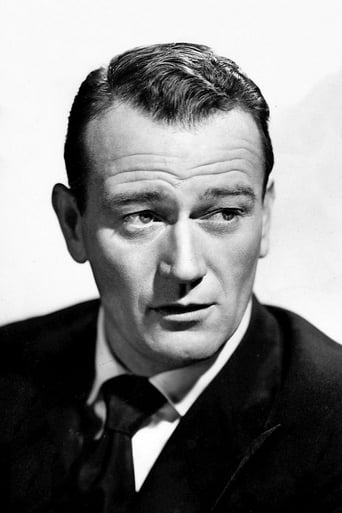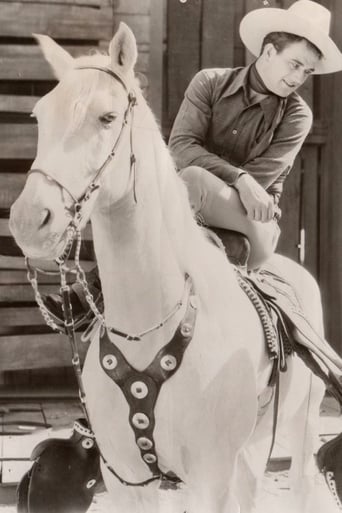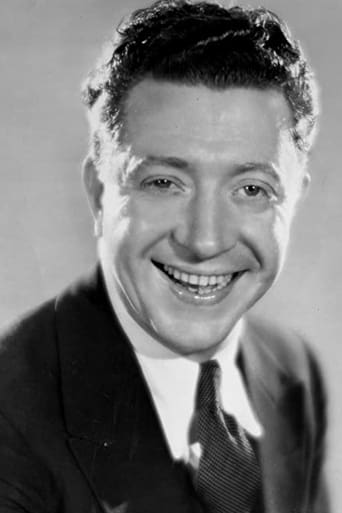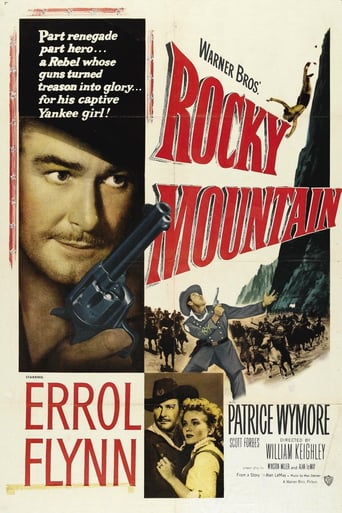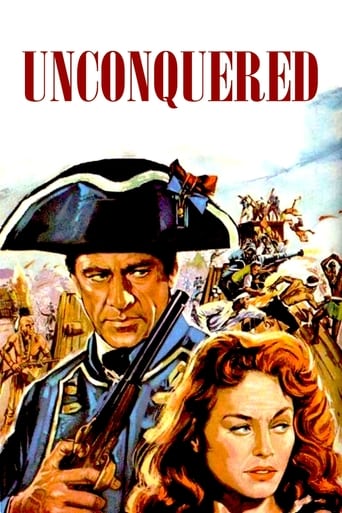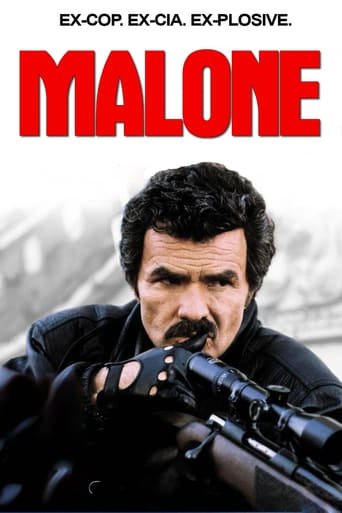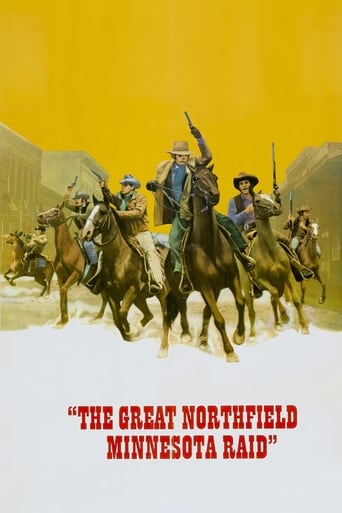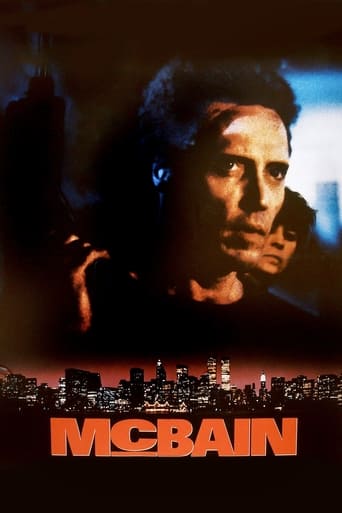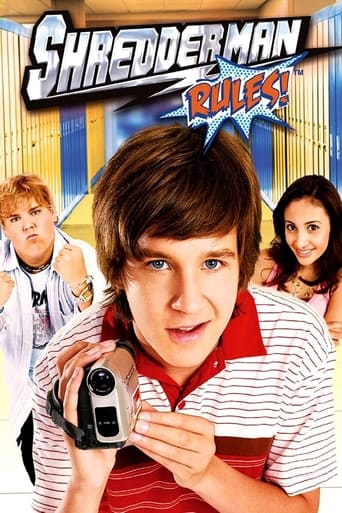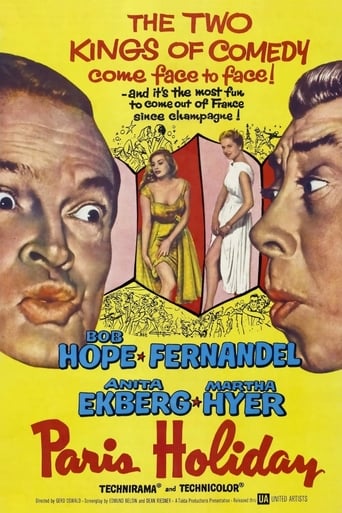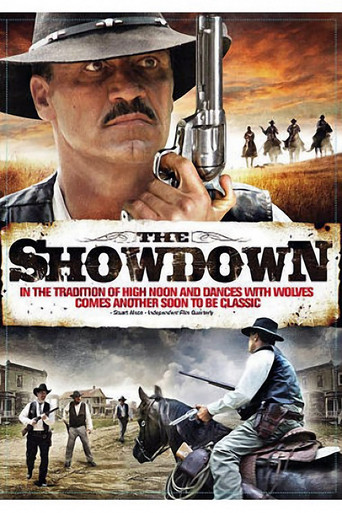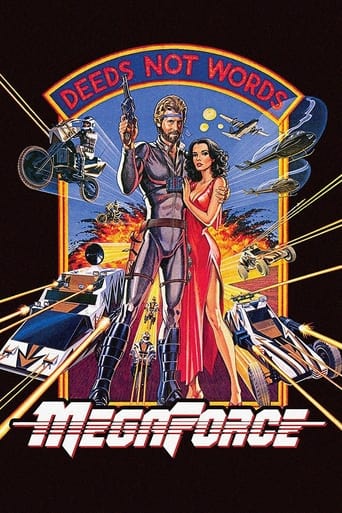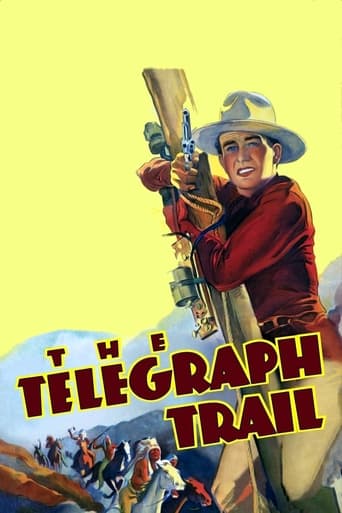
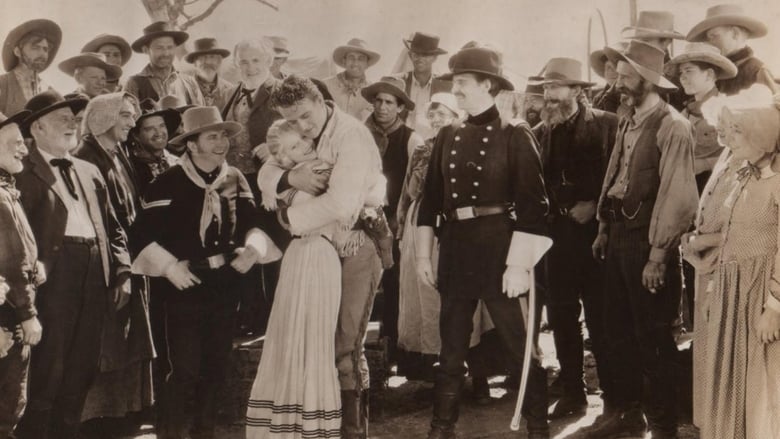
The Telegraph Trail (1933)
A greedy businessman-turned-renegade foments an Indian uprising against the coming telegraph to perpetuate his economic stranglehold on the territory.
Watch Trailer
Cast


Similar titles
Reviews
John Wayne (John Trent), Marceline Day (Alice Ellis), Frank McHugh (Sergeant Tippy), Otis Harlan (Zeke Keller), Albert J. Smith (Gus Lynch), Yakima Canutt (High Wolf), Lafe McKee (Lafe, old-timer), Clarence Geldert (Cavalry commander), Slim Whitaker, Frank Ellis, and "Duke".Director: TENNY WRIGHT. Screenplay: Kurt Kempler. Suggested by the 1927 scenario The Red Raiders by Marion Jackson. Photography: Ted McCord. Film editor: William Clemens. Music director: Leo F. Forbstein. Western Electric Sound System. Associate producer: Sid Rogell. Producer: Leon Schlesinger.Copyright 25 March 1933 by The Vitagraph Pictures, Inc. A Warner Bros-First National Picture. No New York showcasing. U.S. release: 18 March 1933. U.K. release: 17 April 1933. 59 minutes.SYNOPSIS: For reasons that are never made clear, a white trader stirs up the Indians to attack the telegraph linesmen and construction workers. NOTES: As far as I know, this is the only film directed by Tenny Wright, one-time silent film actor and assistant director who rose to become production manager at Warner Bros where he made important contributions to just about all the famous Warner features of the 30s and 40s. COMMENT: Instead of re-making the 1927 Ken Maynard western, "The Red Raiders", this time producer Schlesinger (of later Merrie Melodies and Looney Tunes fame) decided to have a new story fashioned around the original film's truly spectacular action footage. This was a bad mistake. Not only is the new plot weak, but it's full of holes, inconsistencies and downright stupidities. The whole business with the box — what did they need a big empty box for, in the first place? — is a good example of the writer's haphazard approach. At first it seems the box is fairly solid, but later on it's revealed there's a hole in the side big enough for the girl to put her hand through. The heroine's actions throughout are almost totally unbelievable, but the hero's are only marginally more convincing, mostly because he is called upon to react to, rather than initiate events. His reaction times are stupendously slow. From the very first scene with the telegraph message from Jonesy, it takes a considerable time for the import of the message to sink into his thick skull. It seems to go against the whole canon of "B"-western lore to infer the hero is slow-witted, but this suggestion of brawn with no brains is confirmed in his very first encounter with the heroine in which he displays a similar, singular lack of even basic mental acuity. His immaturity is then further demonstrated by his complete change of attitude towards the girl. No wonder John Wayne constantly looks uncomfortable, hesitant, even confused! The support players are of even less help. McHugh and Harlan are both over-zealous bores whose comic cut-ups provide little genuine amusement. Albert J. Smith does what he can with the heavy but is stymied by a script that provides him with virtually no motivation. Canutt plays the Indian in a totally clichéd manner.Wright's slack, slow direction is compounded by the cutting in of obviously silent-speed material. Along with McCord's deliberately flat photography (to tone in with the copious Red Raiders action directed by Albert Rogell), these technical credits lend the movie the air of a musty if awesomely spectacular museum piece. Wayne's efforts to regain his "A" standing certainly took a backward jolt with this entry.
The opening credits proclaim this film a Four Star Western, but in actuality it was a Warner Brothers unit that John Wayne made six movies for in 1932/1933 before moving on to B Studio Lone Star Productions. These pictures aren't easy to come by so it was a pleasant surprise to catch it the other day on the Encore Western Channel, just recently revamped with new logos and screen graphics.The biggest kick I got out of this picture had to do with the captioning, and I have the feeling that someone at the service might have had some larceny in their heart when they worked the scene when bad guy Gus Lynch (Albert J. Smith) confronts John Trent (John Wayne) and his sidekick Tippy (Frank McHugh) for the first time at Zeke Keller's Trading Post. Lynch pinches Tippy's nose hard and puts him down to the ground before going after Trent. When Tippy gets up, he says what sounded to me like, "He got my nose". However the captioning had "This f...in' nose" and it caught me off guard so completely that I replayed the scene four times to see if I had it right (I had the picture DVR'd). My immediate thought was that the captioner might have been inspired by a scene in both versions of "The Longest Yard". Anyway, chances are this goof, if it was a goof, will be corrected soon enough, but folks, believe me when I tell you, it was there! Well with that out of the way, let's get to the story. I was somewhat surprised to see Frank McHugh in the picture as John Wayne's sidekick. Generally he'll show up in more than a handful of Jimmy Cagney flicks, which brings up an interesting trivia note. In Cagney's "Footlight Parade", also released in 1933, his character watches this film as a theater marquee announces "Silent Pictures are Finished". As one would expect, McHugh's Corporal Tippy provides the picture's comic relief, a running gag of his having to do with the gals he left behind stretching all the way from Topeka to Nogales and several points in between.As in most of John Wayne's early Westerns there's a pretty gal on hand. In this case it's Marceline Day as Alice Keller, who concocts a story about being engaged to Wayne's character based on a picture she sees of him, in order to thwart a marriage proposal from bad guy Lynch. The story line has some fun with the misunderstanding, particularly with Corporal Tippy's grievance over his buddy having a secret girlfriend. This all plays out to a conclusion that would happen again and again with Wayne's early Westerns, in as much he closes out the picture giving his gal a kiss.The action scenes in the film consist mostly of an Indian attack instigated by Lynch who's in cahoots with Indian White Wolf (Yakima Canutt). With Trent attempting to complete a telegraph line in the territory, Lynch incites White Wolf with the idea that a completed line will bring in more settlers who will kill off the Indians. In reality, Lynch means to preserve his strangle hold on commerce in the area by disrupting any competing supply sources while gouging settlers with his prices.Before closing I really need to mention Wayne's horse. In this, as in all six of his Warner pictures, Wayne rode a light colored horse listed in the opening credits as 'Duke'. Duke was quite resourceful during the Indian attack, lining himself up to dispatch a couple of renegades through a tent while protecting Miss Alice. Earlier he had some comical scenes with Tippy as well. I'd really like to catch a few more of these Warner Westerns starring Wayne, because in the only other one I've seen, "Haunted Gold", Duke had even more screen time going to bat for the film's hero. Catch that one if you can along with "The Telegraph Trail".
This early John Wayne B-movie is apparently not in the public domain--unlike many of his early films. This Leon Schlessinger film has been released by Warner Brothers/Turner Classic Movies instead of the usual cheap public domain videos you see in bargain bins. Unfortunately, however, despite this higher pedigree (and a slightly better quality print), this isn't all it's cracked up to be--there are no DVD extras nor are there any captions. It's a rather unimpressive release for Warner/TCM.Instead of the usual sidekicks (such as the ubiquitous Gabby Hayes), this one features Frank McHugh. While he's a very common actor in Schlessinger (whose studio was soon bought by Warner) and Warner Brothers films of the era, I can only recall a few times where he appeared in westerns. He was more of the comic relief in contemporary period pieces--though he does a very nice job here and looked pretty comfortable on a horse.The film begins with a group of telegraph installers being attacked by American-Indians. These Indiand, however, were orchestrated by a jerk named Lynch--who wanted to keep the telegraph and civilization away in order to force the settlers to deal with only him and his over-priced supplies. Although one of the telegraph men is shot, he's still able to relay a message to the fort many miles away--and Wayne and McHugh come to investigate. The message told what was happening but the man couldn't finish his transmission--and Wayne is trying to discover who the white man is who is stirring up all the Indian trouble. This is a weak point of the film, as it's 100% obvious who is behind it--there's no suspense whatsoever! Later, a lady overhears Lynch's plans to attack another group of telegraph installers. I have no idea why she didn't just tell Wayne. Instead, she devised a ridiculously complicated and sure to fail method to alert Wayne without revealing her identity. Why....?! And, as she was a witness to the conspiracy between Lynch and the Indian (Yakima Canutt), why didn't she just tell everyone so that Lynch would be arrested and...um...lynched! Then, they all could have gone out for pizza and had a party. Instead, the film went on for another 30 minutes---climaxing with a clichéd Indian attack--which is headed off at the last minutes by (surprise of surprises) the US Cavalry! The are absolutely no major surprises in this film. As usual, Wayne is very good and McHugh was a much better than normal sidekick...but even these couldn't overcome bad writing--even by cheap B-movie standards! It is entertaining...but a bit brainless.
"The Telegraph Trail" was one of six "B" westerns that John Wayne and his horse "Duke" made for Warner Bros. for the 1932-33 season. In this minor entry, Wayne helps bring the telegraph to the old west.After a pal is killed in an Indian raid on the telegraph, army scout John Trent (Wayne) volunteers to help get to the bottom of the raids. With his sidekick Cpl. Tippy (Frank McHugh) he rides in to organize the workers and ensure that the supplies get through. We learn early that Gus Lynch (Albert J. Smith) is inciting local renegade chief, High Wolf (Yakima Canutt) to raid the workers.Trent organizes the workers led by Lafe (Lafe McKee) and work on the final link of the telegraph begins. He also becomes romantically involved with Alice Keller (Marceline Day) after she tells her uncle Zeke (Otis Harlan) that she is engaged to Trent in order to fend off the aspirations of Lynch. When it seems that Trent might succeed in setting up the telegraph line, Lynch and High Wolf plan a mass attack on the worker's camp and..............Yakima Canutt was known primarily for his expert stunt work. It was around this time that he and Wayne became friends and Canutt would work with him throughout the 30s teaching him how to stage a screen fight, walk, as well as, double him in the more difficult stunts. Frank McHugh was poised to graduate to "A" features in support of his friend James Cagney and others. Marceline Day makes an appealing heroine and even gets to embrace the hero, unusual for "B" westerns where the hero generally saved his embraces for his horse.The climatic Indian Raid is mostly stock footage from the silent days inter cut with silly interludes of McHugh and Harlan shooting "multiple" Indians and Wayne going for help. There's one scene where Wayne is shot from a telegraph pole and rises up without a scratch (I know, I know, he was probably playing possum...NOT).Not the best of Wayne's Warner Bros. films but better than most of the Poverty Row Lone Star Westerns which followed this series.


